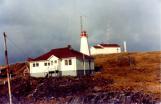1
Abandoned lightkeepers house and automatic light at South-East Light20th Century
St. Paul's Island, Nova Scotia, Canada
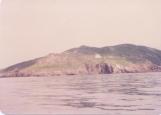
2
Life on St. Paul's IslandIn September of 1955 we left to go to St. Paul's Island. We boarded the government supply ship the Lady Laurier at Neil's Harbor. Early the next morning the ship stopped at the island and we went ashore by life-boat.
3
Abandoned Governor's house at the lifesaving station, Atlantic cove20th Century
St. Paul's Island, Nova Scotia, Canada
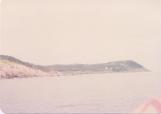
4
On the island there were three families, each about a mile apart. On the south-west end there was just a lighthouse which my father was to take over. The opposite end was called the north-east where there was a radio beacon, fog alarm and a lighthouse, so the light keeper needed two assistants. In the center there was a radio station that was closed down a year later, leaving only two families.5
Atlantic Cove- The landing stage, dwelling, OIC residence, radio office and transmitting antenna20th Century
St. Paul's Island, Nova Scotia, Canada
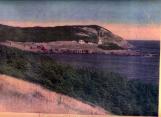
6
We visited a spot where a British troop-ship, the Viceroy of India, taking British soldiers home from the war of 1812, ran ashore with a loss of 500 soldiers. Only two were saved, and one of those died on the island. Next we visited the place where a Norwegian immigration ship ran ashore with a loss of 250 lives. Most of the bodies recovered were buried in a common grave.7
Cape North as seen from the skidway North-east light. The big island is in the foreground20th Century
St. Paul's Island, Nova Scotia, Canada

8
Then, very near our own dwelling, there was the cove where a small ship from Pictou ran ashore on Christmas Eve. After reacting shore safely, all 10 of the crew died of starvation on the island. All crew members were from Charlottetown and Pictou. Each of these coves bears the name of the ship wrecked there.9
Lighthouse and Keeper's residence on North East Islet20th Century
St. Paul's Island, Nova Scotia, Canada
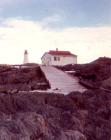
10
Shortly after our arrival, my sister and I started our correspondence lessons. Our school hours were from 1:00p.m. until 4:30p.m. In the evening we studied from 6p.m. until 8p.m. our mornings were left to our selves to be spent as we wished. Some mornings we went a mile and a half to launch a boat to go fishing. Almost anywhere off the island there is an abundant supply of fish. Other times we took guns and went hunting for wild duck. The last year we were there (from 1959-60) I shot 34 ducks. In summer we went swimming on either one of the two lakes on the top of the island.11
Northeast Lighthouse nestled in the rocks20th Century
St. Paul's Island, Nova Scotia, Canada
 Credits:
Credits:The North Highlands Community Museum
12
About every three or four months a supply ship calls at the island with mail and supplies. Imagine the excitement of receiving all the mail at one time. Of coarse we couldn't wait to see what marks we made on out papers. With about 12 papers to look over, it took some time.13
Living quarters with light, engine room and beacon behind, Northeast Light20th Century
St. Paul's Island, Nova Scotia, Canada
